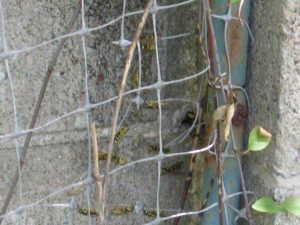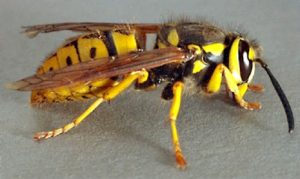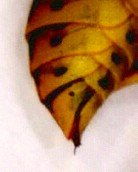
YELLOW JACKETS The yellow jacket nest in the wall around my garden. They eat lot of aphids and other insects in the garden. They are not aggressive unless threatened or you disturb their nest. They seem to be extracting something from the plastic netting near the nest. Maybe something they are using to build the nest, but it’s strange to me. They use plant fiber to chew and build a paper nest. These are pictures of them and the little hole in the wall leads to their nest.
Common Yellow Jacket

German Yellow Jacket

Stinger

In North America, Vespula vulgaris is the name of the common yellow jacket. This common wasp builds its grey paper nest in or on a structure capable of supporting it. Underground, it often uses an abandoned mammal hole as a foundation for the nest, which is then enlarged by the workers. The founding queen may select a hollow tree, wall cavity or rock crevice for a nest site.
The common yellow jacket is black and yellow. The face lacks the three black dots characteristic of that species. No black dots on its back, which are located further up and form part of the black rings on each of the abdomen’s six segments. The part of the head to which the jaws of an insect are attached is usually broken by black (sometimes narrowly).
Each wasp colony includes one queen and a number of sterile workers. Colonies usually last only one year, with all but the queen dying at the onset of winter. New queens and males (drones) are produced towards the end of the summer, and after mating, the queen overwinters in a hole or other sheltered location sometimes in buildings. Wasp nests are not reused from one year to the next. This common wasp collects insects, including caterpillars, to feed to its larvae; the adults feed on nectar and sweet fruit. Common wasps will also attempt to invade honeybee nests to steal their honey; the bees will attempt to defend their nest by stinging the wasp to death.
German wasps are part of the family Vespidae and are sometimes referred to as paper wasps because they build grey paper nests. Strictly speaking, paper wasps are part of the subfamily Polistinae. In North America, they are known as yellow jackets. It has typical wasp colors of black and yellow and is very similar to the common wasp, but seen head on. Its face has three tiny black dots. German wasps have black dots on their abdomen, while the common wasp’s analogous markings are fused with the black rings above them, forming a different pattern.
The nest is made from chewed plant fibers mixed with saliva. It is generally found close to or in the ground, rather than higher up on bushes and trees like hornets. It has open cells and a petiole attaching the nest to the substrate. The wasps produce a chemical that repels ants, and they secrete it around the base of this petiole to avoid ant predation.
A solitary female queen starts the nest, building 20–30 cells before laying eggs. This phase begins in spring, depending on climatic conditions. She fashions a petiole and produces a single cell at the end of it. Six further cells are added around this producing the hexagonal shape of the nest cells. Once the larvae have hatched as workers, they take up most of the colony’s foraging, brood care and nest maintenance. A finished nest may be 20–30 cm across and contain 3,000 individuals. Colonies usually last only one year, all but the queen dying at the onset of winter. However, in mild climates such as New Zealand, around 10% of the colonies survive the winter. New queens and males (drones) are produced towards the end of the summer, and after mating, the queen overwinters in a crack or other sheltered location.
This common and widespread wasp collects insects, including caterpillars, to feed to its larvae, and is therefore generally beneficial. The adults feed on nectar and sweet fruit, and are also attracted to human food and food waste, particularly sodas and meats.
Yellow jacket wasps can be up to an inch long. They are distinctive not only because of their black and yellow, or sometimes black and white, color, but also because their bodies have a definite waist and they fold their wings lengthwise.
The major difference between yellow jackets and hornets lies in their food preferences and their aggressiveness towards people. Early in the summer, yellow jackets are not normally aggressive towards people unless their nest is threatened. During this time, workers capture other insects as prey to feed to the larvae. In late summer through early fall, August through October, yellow jackets become troublesome and dangerous. Their food preference switches from proteins to sweets, and they scavenge at garbage cans and picnic tables. This is when workers are more likely to sting, even when away from the nest.
Yellow jackets and hornets are in the insect family Vespidae. A key character of wasps in this family is that they fold their wings lengthwise when at rest. The wasps known as yellow jackets actually include many different species. Most yellow jackets, true to their name, are yellow and black. Species are best differentiated by the pattern of the yellow and black markings on the abdomen. One notable exception to the black-and-yellow color scheme is the bald-faced hornet. The light markings on individuals of this species are white rather than yellow. Yellow jacket and bald-faced hornet workers are about 1/2-inch in length; queens are somewhat larger at 3/4-inch. The European or giant hornet is one of the largest members of the family at a whopping 1 inch.
Commercially available yellow jacket traps may help to reduce the yellow jacket population. Place the traps at the perimeter of your recreation area 30 minutes before the guests arrive at an outdoor event, such as a cookout. Protein baits, such as meat scraps or dog food, work best in early summer. Sweat meats like jelly, ripe fruit, or grenadine syrup, should be used in late summer and early fall. Replace the bait with fresh bait every day, first submerging the trap in water to kill any yellow jackets inside.
There are actually seventeen species of yellow jackets in North America. In most of North America, yellow jacket colonies flourish during the summer and die off in the winter. Yellow jackets build their nests in the ground or attached to branches. Sometimes they will make one in the walls of a building. The Western yellow jacket nests on the ground, often building a nest under porches or in cracks in structures. Unlike many other wasps, which are exclusively predators, the western yellow jacket is also a scavenger … it is particularly attracted to garbage and anything with sugar in it. This scavenging makes it a pest, but it is what allows it to survive late into the fall.
A hollow stinger is located at the rear of the yellow jacket’s body. When it penetrates the skin, venom is injected through the stinger. It takes about 1,500 stings to kill an adult man. If a nest of yellow jackets is disturbed, workers will aggressively defend it by stinging. Yellow jackets can sting more than once. Usually a sting is just a temporarily painful experience, resulting in redness, itching and pain.
When yellow jackets start their new nests in the spring, they are most vulnerable before they produce workers that can protect the nest. These nests are difficult to locate due to their small size. Once the nest is larger and workers are foraging, you can follow workers as they return to the nest. It is always a good idea to find the yellow jacket nest before these wasps find you.
Yellow jacket Stings
Yellow jackets can sting many times, and usually do not die after stinging. Once stung, the victim is marked by an alarm odor that excites nearby wasps to repeatedly sting the hapless victim. About 40 people die annually from stings, and many others are hospitalized.
For people who are allergic, a single sting may result in a serious reaction, or in some cases, death. Between 0.5 and 1.0 percent of the population may be allergic to yellow jacket venom. Yellow jackets are also sometimes responsible for infection … a contaminated stinger can inject bacteria beneath the victim’s skin, causing blood poisoning.
People who have a history of allergies, heart problems, or known sensitivity to stings should be very careful and seek medical advice when stung. Most people only suffer temporary pain when stung. Cooling the affected area with cold water or ice can reduce this pain.
When stung out of doors, immediately vacate the area to distance yourself from a possible wasp nest. Look carefully for nests before doing yard or outdoor work. Wear foot protection out of doors. Do not eat tuna, chicken or other smelly foods outdoors when wasps are actively hunting for food. Wasps may enter soft drink containers before you lift them to your mouth since wasps are attracted to sweets. Wash the hands and mouths of children before sending them out to play.
If the victim is wearing thin clothing, the wasps can sting right through the clothing. A normal reaction to a sting involves only swelling in the immediate area of the sting and appears in 2 to 3 minutes. It involves redness, itching, pain and formation of a welt at the site. Usually the symptoms go away within two hours.
Yellow jackets can kill people in two ways. The sheer numbers of stings can cause toxic effects such as severe headache, vomiting, diarrhea, and shock. In sensitive individuals an allergic reaction may occur. It generally takes about 1,500 stings to kill an adult man by the venom alone. Children are more susceptible to the venom because of their lower body weight. A child that died from yellow jacket stings a few years ago supposedly was stung 300 to 400 times.
For allergic people, one sting can be deadly. In fact, a severe allergic reaction can result in death within 15 to 30 minutes. Severe reactions start with local pain and itching that eventually becomes widespread skin irritation. The victim feels tightness in the throat and chest and breathing becomes difficult. A study of 641 deaths due to yellow jackets, bees, and wasps reported that respiratory congestion caused 53% of the deaths.
If you are stung, the treatment for a normal or mild reaction is: apply ice pack, take a pain reliever and wash the wound carefully. Oral antihistamine may reduce swelling that can occur. Calamine products can reduce the itching. For swelling and tenderness around the sting bites, rest and elevate the limb and avoid exercise. Medical attention may be needed if the sting is around the throat, nose or eye area.
If you are allergic to stings, there are some avoidance techniques you can use. You can lessen your attractiveness to yellow jackets if you forego the use of hairspray, perfume, or aftershave and don’t wear bright-colored clothing, especially bright yellow, light blue, red, or orange. Good choices are white or light tan fabrics that are unattractive to them. Wear shoes when walking through lawns. Keep car windows closed whenever possible. Be cautious when working in the garden or trimming hedges, and avoid apple orchards. If you do end up in an area where yellow jackets are present, don’t swat them–this will only increase your chance of being stung. Try to remain calm and walk away. Never crush a yellow jacket. A dying yellow jacket worker releases an alarm pheromone that alerts its nest mates. In just a few seconds, you could find yourself surrounded by angry wasps.
Integrated pest management for yellow jackets should center on reducing accessibility of food, combined with trapping and treatment of nests. I f yellow jackets crash your next picnic, serve drinks in cups with lids and straws; don’t leave empty plates, cups, or drink cans lying around; and keep serving platters covered.
